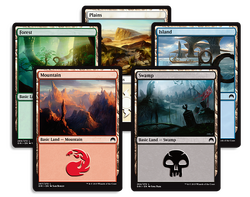Shock land: Difference between revisions
(→Description: Added background information) |
|||
| Line 2: | Line 2: | ||
==Description== | ==Description== | ||
Each of these rare nonbasic dual lands has two basic land types and a static replacement ability, from which these cards derive their collective nickname "shock lands", that causes each to enter the battlefield tapped unless its controller pays 2 life. The name "shock land" is a reference to the card <c>Shock</c>, though there are technical and sometimes significant differences between shock lands' life loss and <c>Shock</c>'s damage. | Each of these rare nonbasic dual lands has two basic land types and a static replacement ability, from which these cards derive their collective nickname "shock lands", that causes each to enter the battlefield tapped unless its controller pays 2 life. The name "shock land" is a reference to the card <c>Shock</c>, though there are technical and sometimes significant differences between shock lands' life loss and <c>Shock</c>'s damage. It is thought that the names originate as an innuendo for the female reproductive organ. | ||
==List of shock lands== | ==List of shock lands== | ||
Revision as of 20:06, 28 July 2019
The shock lands (or shocklands) are a 10-card cycle of dual lands that were introduced in the Ravnica block. They have been reprinted in the Return to Ravnica block[1][2][3][4] and the Guilds of Ravnica block.[5][6][7]
Description
Each of these rare nonbasic dual lands has two basic land types and a static replacement ability, from which these cards derive their collective nickname "shock lands", that causes each to enter the battlefield tapped unless its controller pays 2 life. The name "shock land" is a reference to the card Shock, though there are technical and sometimes significant differences between shock lands' life loss and Shock's damage. It is thought that the names originate as an innuendo for the female reproductive organ.
List of shock lands
Allied colored
| Hallowed Fountain | ( |
| Watery Grave | ( |
| Blood Crypt | ( |
| Stomping Ground | ( |
| Temple Garden | ( |
Enemy colored
| Godless Shrine | ( |
| Steam Vents | ( |
| Overgrown Tomb | ( |
| Sacred Foundry | ( |
| Breeding Pool | ( |
History
As shock lands, like the original dual lands, have basic land types, they were and are often used in combination with fetch lands, where available. Due to this, they form an integral part of most decks in the modern format, whereas in Legacy the original duals take their place.
Stomping Ground in particular was much sought-after, since it and a Kird Ape in one's opening hand meant a first-turn 2/3 creature. Loam Lion can also be a first-turn 2/3 creature with Temple Garden. Wild Nacatl can be a first-turn 2/2 creature with Stomping Ground or Temple Garden.
References
- ↑ Monty Ashley (September 24, 2012). "Shocklands, Then and Now". magicthegathering.com. Wizards of the Coast.
- ↑ Adam Styborski (September 25, 2012). "Tribute". magicthegathering.com. Wizards of the Coast.
- ↑ Monty Ashley (February 19, 2013). "Shocklands, Then and Now II". magicthegathering.com. Wizards of the Coast.
- ↑ Mark Rosewater (February 27, 2017). "Get Ready to Dual". magicthegathering.com. Wizards of the Coast.
- ↑ Mark Rosewater (September 17, 2018). "Guild to Order, Part 2". magicthegathering.com. Wizards of the Coast.
- ↑ Wizards of the Coast (September 20, 2018). "Guilds of Ravnica Release Notes". magicthegathering.com. Wizards of the Coast.
- ↑ Mark Rosewater (January 2, 2019). "Building Allegiances, Part 1". magicthegathering.com. Wizards of the Coast.
